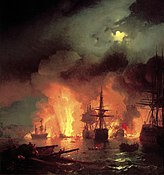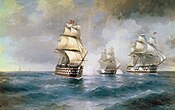Ivan Aivazovsky
- Birth Date:
- 29.07.1817
- Death date:
- 02.05.1900
- Length of life:
- 82
- Days since birth:
- 75840
- Years since birth:
- 207
- Days since death:
- 45611
- Years since death:
- 124
- Extra names:
- Ivans Aivazovskis, Иван Айвазовский, Ованнес Айвазян, Հովհաննես Կոնստանդինեսի Այվազյան, Ovaness Aivazjans, Ованнес Айвазян, Հովհաննես Կոնստանդինեսի Այվազյ
- Cemetery:
- Set cemetery
Ivan Aivazovsky (Armenian: Հովհաննես Այվազովսկի Hovhannes Aivasovsky, originally Aivazian; Russian: Иван Константинович Айвазовский) (July 29, 1817 – May 5, 1900) was an Armenian-Russian world-renowned painter living and working in Crimea, most famous for his seascapes, which constitute more than half of his paintings. Aivazovsky is widely considered as one of the greatest seascape painters of all times.
Biography
Aivazovsky was born in the town of Feodosiya (Theodosia), Crimea (Russian Empire) to a poor Armenian family. His brother was the Armenian Archbishop Gabriel Aivazovsky. His family moved to the Crimea from Galicia (then in southern Poland, now in Ukraine) in 1812. His parents' family name was Aivazian but in Poland it was written Haivazian. Some of the artist's paintings bear a signature, in Armenian letters, "Hovhannes Aivazian" (Հովհաննես Այվազյան). His father taught him to play the violin and speak Polish and Ukrainian fluently. His talent as an artist earned him sponsorship and entry to the Simferopol gymnasium №1 and later the St.Petersburg Academy of Arts, which he graduated with a gold medal. Earning awards for his early landscapes and seascapes, he went on to paint a series of portraits of Crimean coastal towns before travelling throughout Europe. In later life, his paintings of naval scenes earned him a long-standing commission from the Russian Navy stationed in the Black Sea.
In 1845, Aivazovsky went to İstanbul upon the invitation of Sultan Abdülmecid I, a city he was to travel to eight times between 1845–1890. During his long sojourn in İstanbul, Aivazovsky was commissioned for a number of paintings as a court painter by the Ottoman Sultans Abdülmecid, Abdulaziz and Abdulhamid, 30 of which are currently on display in the Ottoman Imperial Palace, the Dolmabahce Museum and many other museums in Turkey. His works are also found in dozens of museums throughout Russia and the former Soviet republics, including the Hermitage Museum in Saint Petersburg. The largest collections of his works are at the Aivazovsky Art Gallery in Feodosiya, Ukraine, and the National Gallery of Armenia.
At 31, Aivazovsky married Julia Graves, an English governess in St. Petersburg. They had four daughters. The marriage was dissolved, and at the age of 65, Aivazovsky, married Anna Boornazian, a young Armenian widow from Theodosia.
Aivazovsky was deeply affected by the Hamidian massacres of Armenians in Asia Minor in 1895, painting a number of works on the subject such as "The Expulsion of the Turkish Ship," and "The Armenian Massacres at Trevizond." and renouncing a medal which had been awarded to him in İstanbul. He spent his last years in Feodosia where he supplied the town with water from his own estate, opened an art school, began the first archaeological excavations in the region and built a historical museum. Due to his efforts a commercial port was established at Feodosiya and linked to the railway network.Aivasovsky died in Feodosiya in 1900.
Style and subject matter
Aivazovsky is best known for his seascapes and coastal scenes. His technique and imagination in depicting the shimmering play of light on the waves and seafoam is especially admired, and gives his seascapes a romantic yet realistic quality that echoes the work of English watercolorist J. M. W. Turner and Russian painter Sylvester Shchedrin. Especially effective is his ability to depict diffuse sunlight and moonlight, sometimes coming from behind clouds, sometimes coming through a fog, with almost transparent layers of paint. A series of paintings of naval battles painted in the 1840s brought his dramatic skills to the fore, with the flames of burning ships reflected in water and clouds. He also painted landscapes, including scenes of peasant life in Ukraine and city life in İstanbul. Some critics have called his paintings from İstanbul Orientalist, and others feel the hundreds of seascapes can be repetitive and melodramatic.
Success
Aivazovsky became the most prolific Russian painter of his time. Early in his career, he was elected a member of five Academies of Fine Arts, including those of St. Petersburg (his Alma Mater). Rome, Florence, Stuttgart and Amsterdam. He was an Academician at 27, and Professor of Marine Painting at the Academy of Fine Arts, St. Petersburg, at the age of 30.
His works were highly appreciated by J.W.M. Turner, a leading English landscape and marine painter, when they met in Rome, in 1842. The art of the young marine painter Aivazovsky inspired Turner to devote a poem to him.
Aivazovsky left over 6,000 works at his death in 1900. The funds earned during his successful career as an artist enabled him to open an art school and gallery in his hometown of Feodosiya.
As of 2006, Aivazovsky's works have been auctioned for as much as $3,200,000, and his international reputation continues to grow.
On June 14, 2007 his painting "American Shipping off the Rock of Gibraltar" sold for 2,710,000 pounds, "the highest price paid at auction for Aivazovsky". He is also said to be the most forged of all Russian painters.
On April, 2012, Ivan Aivazovsky’s canvas View of Constantinople and the Bosphorus was sold at Sotheby’s auction in London for a record $5.2 million (3.2 million pounds).
He is in the highest category #1 - an artist of the world fame, tested with time (for no less than a century)" in "United Artists Rating".
Legacy
A minor planet 3787 Aivazovskij, discovered by Soviet astronomer Nikolai Stepanovich Chernykh in 1977 is named after him.
Aivazovsky is referenced in Anton Chekhov's play Uncle Vanya.
Russia, Ukraine, and Armenia have issued postage stamps of Aivazovsky's works
Gallery
-

A Strong Wind, 1856.
-

View of the Sea by Moonlight, 1878.
-

Moonlit Seascape With Shipwreck
-

Storm
-

The Mary Caught in a Storm, 1892.
-

Battle of Navarino
-

Black Sea
-

The Ninth Wave
-

Among Waves
-

Battle of Chesma
-

Stormy Sea in Night
-

Brig "Mercury" Attacked by Two Turkish Ships
Source: youtube, wikipedia.org
No places

Relations
| Relation name | Relation type | Description | ||
|---|---|---|---|---|
| 1 |  | Константин Арцеулов | Grandson | |
| 2 |  | Елена Павловна | Familiar |
28.03.1854 | Turpinās Krimas karš. Osmaņu impērijas pusē karā iesaistās Anglija un Francija
Krimas karu pret Osmaņu impēriju Krievija iesāka 1853. gada oktobrī. Kara iesākšanas iegansts Krievija bija "ortodoksālo kristiešu aizsardzība". Karš ilga trīs gadus, līdz 1856. gada februārim. Kara rezultātā Krievija ieguva Krimas pussalu, bet zaudēja savus iepriekšējos sabiedrotos- kopš 1815. gada Vīnes kongresa laikiem- Franciju, Lielbritāniju, Sardīniju.


